COMPOSITE SQUADRON ONE |
|||
| File No. VC-1/A8 | |||
| Serial No. (19) | |||
c/o Fleet Post Office, |
|||
New York, New York. |
|||
23 August 1943. |
|||
SECRET |
|||
From: |
Commander, Composite Squadron One. | ||
| To: | Commander in Chief, U.S. Fleet. | ||
| Via: | (1) Commanding Officer, U.S.S. CARD. | ||
| (2) Commander in Chief, U.S. Atlantic Fleet. | |||
| Subject: | ASW-6 Report, Forwarding of. | ||
| Enclosures: | (A) ASW-6 Report No. 2-43. | ||
| (B) ASW-6 Report No. 2A-43. | |||
| (C) ASW-6 Report No. 2B-43. | |||
1. Enclosures (A), (B) and (C) are forwarded herewith. |
|||
| C. E. JONES. | |||
| - - - - - - - - - - - - - - - - - - - - - - - - - - - - - - - - - - - - - - - - - - - - - - - - - - - - - - - - - - - - | |||
| CVE-11/A16-3 U.S.S. CARD 23 August 1943. | |||
| (0012) 1st Endorsement | |||
| SECRET-SECURUTY | |||
| From: | Commanding Officer. | ||
| To: | Commander in Chief, U. S. Fleet. | ||
| Via: | Commander in Chief, U. S. Atlantic Fleet. | ||
| 1. Forwarded | |||
| 2. The initial attack by Lt. (jg) Sallenger was entirely unsupported by fighter escort in that the F4F assigned to him had been forced to return to the ship about one hour prior to the attack due to engine trouble. | |||
| 3. In photograph #1 of enclosure (A), Submarine "A" (on right side of picture) has been tentatively identified by Air Intelligence, Gibraltar, as "a type of supply U-boat, tonnage unknown; the circular hatches forward are used for storage of spare torpedoes." Submarine "B" (on left side of picture) has been identified by the same unit as "a 'Milch-cow' U-boat of 1200-1600 tons." | |||
| 4. Lt. (jg) Sallenger's mine attack on Submarine "B" was delivered strictly in accordance with doctrine, and in the face of intense enemy fire from the six (6) 20MM guns of Submarine "A". | |||
| (over) | |||
SECRET-SECURITY |
||||||||||||||||||||||||||||||||||||||||||
| - - - - - - - - - - - - - - - - - - - - - - - - - - - - - - - - - - - - - - - - - - - - - - - - - - - - - - - - - - - - | ||||||||||||||||||||||||||||||||||||||||||
| The mine was dropped on a track paralleling that of Submarine "B" from the plane in horizontal flight at 200 feet altitude, and 130 knots air speed, the mine falling 50 yards to starboard and 150 yards ahead of the swirl about 40 seconds after submergence. | ||||||||||||||||||||||||||||||||||||||||||
| 5. Neither Lt. (jg) Sallenger nor-either of his crew saw any explosion from the mine, nor was it possible for them to observe any shock-wave since they were continually down-sun from a very strong glare, as shown in photograph #7. | ||||||||||||||||||||||||||||||||||||||||||
| 6. Evidence of cumulative damage to the Submarine "A" during the three depth bomb attacks is as follows: | ||||||||||||||||||||||||||||||||||||||||||
|
||||||||||||||||||||||||||||||||||||||||||
| 7. The dropping of the two (2) mines adhered to doctrine, as set forth in attached reports and narratives. Following these attacks: | ||||||||||||||||||||||||||||||||||||||||||
|
||||||||||||||||||||||||||||||||||||||||||
- 2 - |
||||||||||||||||||||||||||||||||||||||||||
23 August 1943. |
||||||||||||||
SECRET-SECURITY |
||||||||||||||
| CVE-11/A16-3 | ||||||||||||||
| (0012) | ||||||||||||||
| Subject:: ASW-6 Report, forwarding of. | ||||||||||||||
| - - - - - - - - - - - - - - - - - - - - - - - - - - - - - - - - - - - - - - - - - - - - - - - - - - - - - - - - - - - - | ||||||||||||||
|
||||||||||||||
| 8. In view of the above evidence, it is considered that Submarine "A" was definitely sunk. | ||||||||||||||
| 9. It is further believed that with the proper functioning of the Mk. 24 mine, which there is no reason to doubt, inasmuch as it was dropped precisely according to doctrine, Submarine "B" was probably sunk. | ||||||||||||||
| A. J. ISBELL. | ||||||||||||||
| Advance Copy Direct to: | ||||||||||||||
| COMINCH | ||||||||||||||
| CONAIRLANT | ||||||||||||||
| COMAIRASDEVLANT | ||||||||||||||
- 3 - |
||||||||||||||
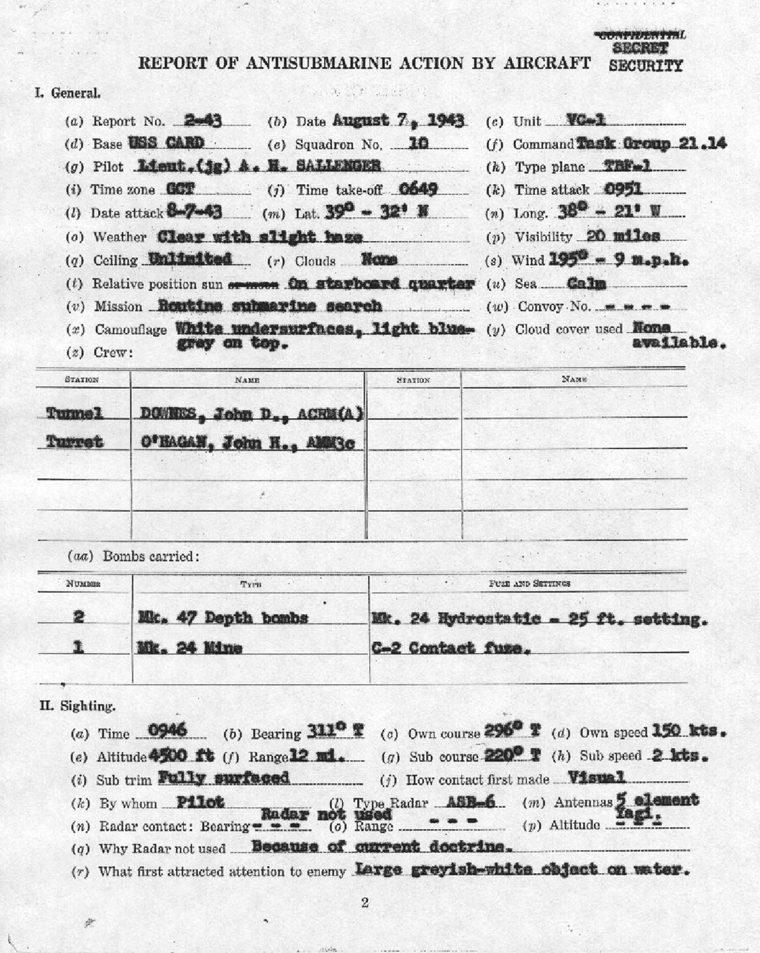
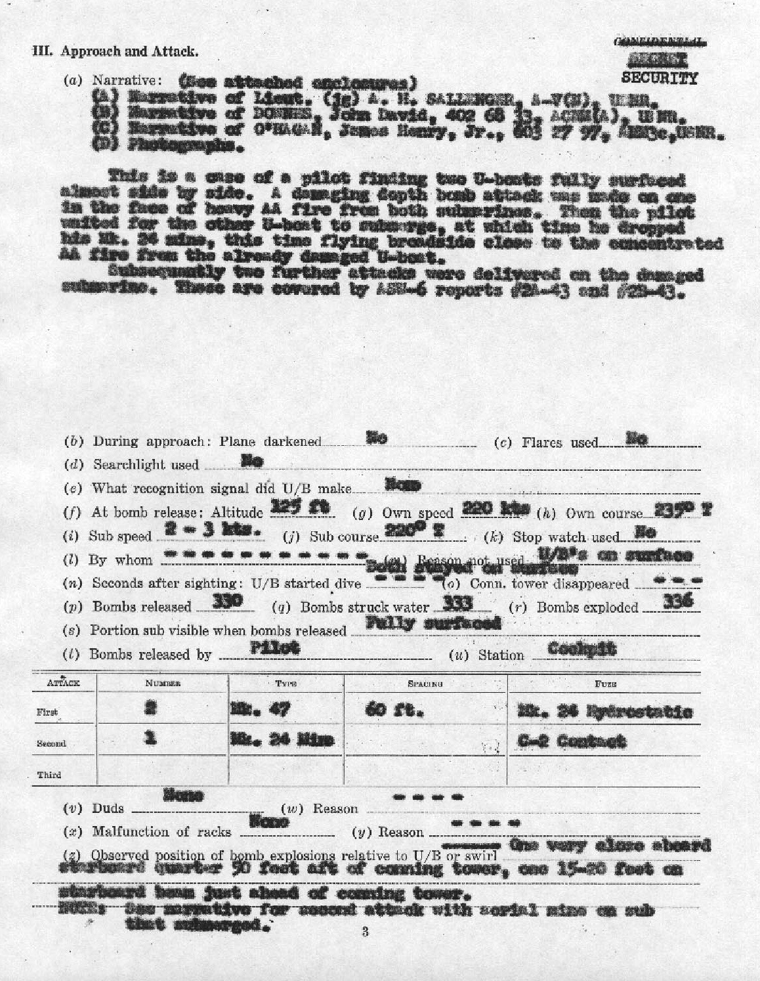
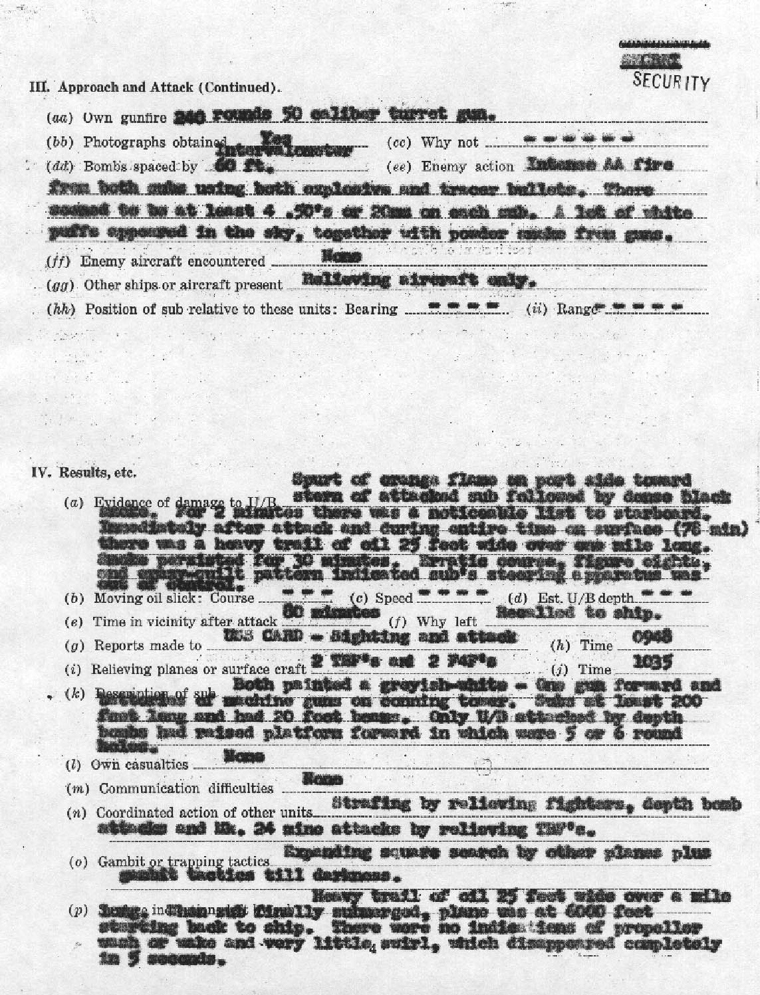
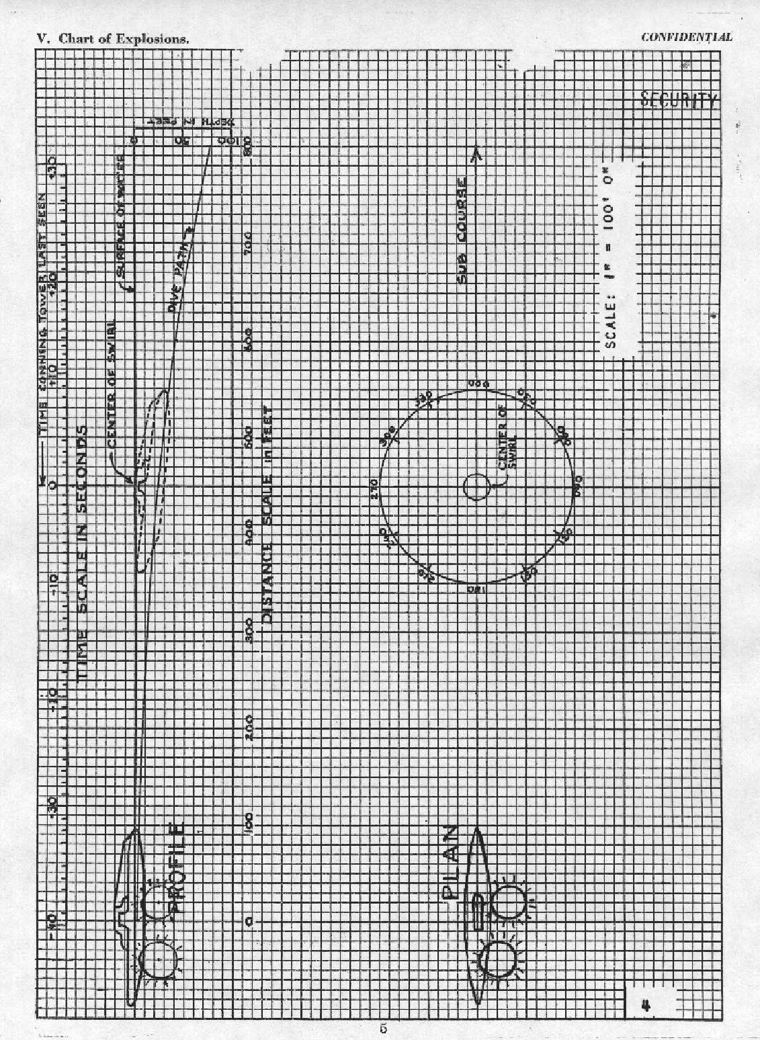
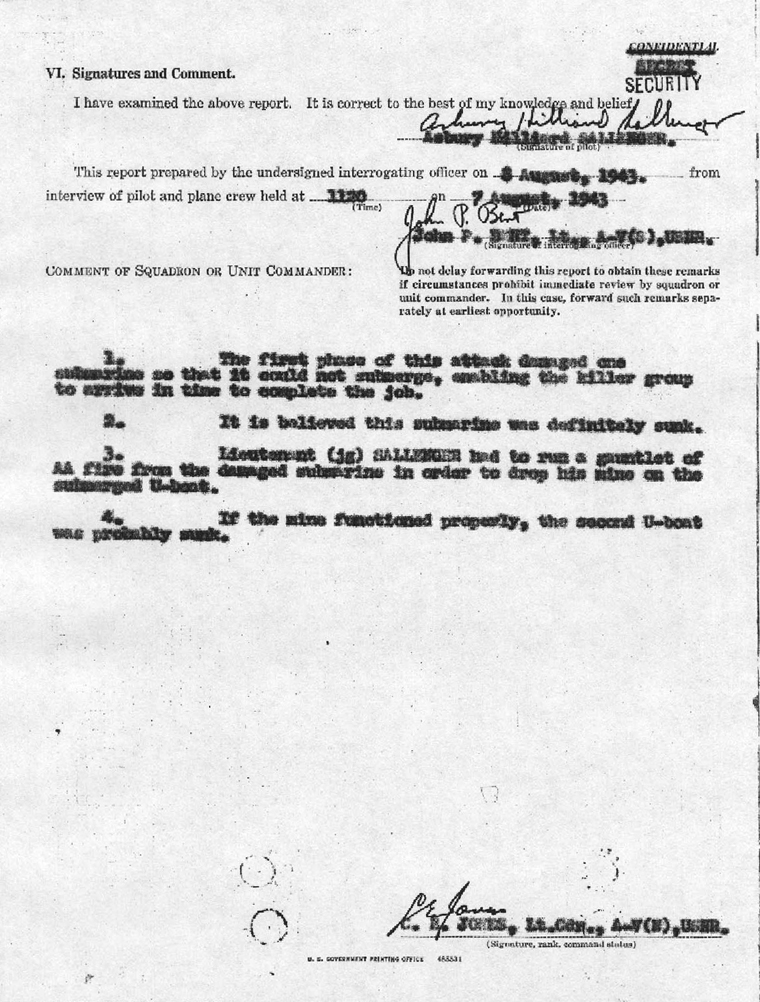
COMPOSITE SQUADRON ONE |
|||
| SECRET-SECURITY | August 7, 1943. |
||
NARRATIVE OF LIEUTENANT (JG) A. H. SALLENGER A-V(N), USNR |
|||
| While proceeding on a track of 2960 T, time 0946 GCT, altitude 4500 feet, speed 150 knots, true airspeed, I spotted a large white object bearing 150 on my starboard bow, distance about 12 miles. At first I thought it was a merchant ship, but I soon realized it was two submarines close together, fully surfaced, cruising very slowly with neither wake nor bow wave. The bearing from the ship was 2980 T, distance 82 miles. The weather was slightly hazy, there was no cloud cover, and as the submarines were on a course of 2200 at a speed of about 2 knots, I maneuvered to come out of the sun. They were almost abreast of one another not more than 200 feet apart. There was no indication that fueling operations had been or were going to be conducted. The sides of both submarines were painted white and seemed to be the same size. | |||
| I made the first attack out of the sun with two Mk. 47 depth bombs set at 25 feet, selecting the submarine nearest me and slightly astern. I approached at a target angle of 1950, speed 220 knots, releasing at an altitude of 125 feet, plane course 2350 T. The submarines were apparently caught unaware and did not open fire with their AA guns until I was about 400 yards away. This fire was very intense from both U-boats, though the plane was not hit. | |||
| The bombs seemed to straddle the U-boat and about 3 seconds later there were two large explosions, one five to ten feet on the starboard quarter half way between the conning tower and the stern and the other just ahead of the conning tower 15-20 feet out. I circled sharply to the left gaining altitude while the turret gunner strafed and the radioman took pictures. The attacked submarine immediately began to smoke badly throwing off a dark greyish black smoke. It began making erratic turns in a crazy quilt pattern trailing a heavy oil slick. I had made a preliminary contact report to the ship before the attack and now made another giving the bearing and distance. I then cut on my IFF and climbed to 6500 feet. | |||
| The undamaged submarine apparently tried to aid the one attacked for about 15 minutes and then started to submerge near the damaged sub. I immediately dove to attack, meeting heavy AA fire from the damaged U-boat. This fire was particularly noticeable because it was necessary to fly directly by the conning tower at 130 knots and 200 feet to drop the Mk. 24 mine about 40 seconds after the undamaged sub had gone down. | |||
| ENCLOSURE (A) - 1 - | |||
COMPOSITE SQUADRON ONE |
||
| SECRET-SECURITY | ||
August 7, 1943. |
||
| NARRATIVE OF LIEUTENANT (JG) A. H. SALLENGER, A-V(N) USNR CONT'D | ||
| The mine was dropped on the last seen course of the submerged sub (1500 T) 50 yards to the starboard and 150 yards ahead of the swirl. Though I watched carefully, neither I nor my crew saw any results of the mine drop. | ||
| Then I climbed back up to 6400 feet so the other planes could be vectored to the spot. In about 20 minutes, 2 TBF-1 and 2 F4F-4 airplanes arrived and attacked the damaged submarine. Eight minutes before the relieving planes arrived, the damaged submarine made an obvious effort to submerge. For a minute I thought he was gone, but he came back up to fully surfaced position almost immediately. Watching from my altitude, the sub still on the surface, was strafed unmercifully by the F4F-4's. About 5 minutes after the depth bomb attack by the 2 TBF's, the sub having been steering an erratic course, seemed to settle slowly, still smoking. About 30 seconds later, the TBF's dropped their Mk. 24 mines, one on either side and ahead of the faint swirl left by the sub. Several minutes later there was another disturbance on the water to starboard and ahead of the last observed position of the U-boat. | ||
| Shortly thereafter, I was recalled to the ship. | ||
| A. H. SALLENGER | ||
| ENCLOSURE (A) - 2 - | ||
COMPOSITE SQUADRON ONE |
||
| SECRET-SECURITY | ||
August 7, 1943. |
||
NARRATIVE OF DOWNES, John David, 402 68 33, ARCM(A), USNR |
||
| Lieutenant (jg) SALLENGER noted something on the water about 12 miles away and told the gunner, who was in the center cockpit, to man his turret, and for me to check my switches, including the electrical arming switches. I checked the bombing set-up and told the pilot all was ready. At first, the object appeared to be a large destroyer, but upon approaching closer, we made it out to be two submarines close together, either laying to or proceeding at a slow rate of speed. There was no wake showing. | ||
| Mr. SALLENGER said, "This is it" and told me to standby with the camera. He approached from astern of the subs and the depth bombs hit the water extremely close to the sub which was slightly astern. Two explosions followed shortly, obscuring the attacked subs from view. I took a picture of the explosions. During the attack, were were under heavy machine gun and anti-aircraft fire from both subs. | ||
| After the explosion cleared, the after sub let out a stream of brown black smoke from aft of the conning tower which continued for some time. | ||
| Mr. SALLENGER had previously called the ship and now called again, giving the ship the results of his attack. The damaged sub was maneuvering very erratically as if its steering apparatus was out of control. The second sub was following the damaged one, apparently trying to help it. About ten minutes later, the second sub submerged, leaving the damaged one on the surface. | ||
| We then made another run and dropped our mine on the submerged sub under more heavy fire from the damaged sub. | ||
| Shortly, the other planes arrived on the scene and the fighters strafed the remaining sub. The two TBF's dropped their depth charges and the sub was again obscured from view by the explosions. A short time later the sub submerged and the 2 TBF's dropped their mines, but I did not notice any results from our altitude of 6000 feet. | ||
| /s/ John David DOWNES | ||
| Note in pen on original: DOWNES is missing in action. This statement therefore is unsigned. | ||
| J. P. BENT | ||
| Lieut. USNR | ||
| ENCLOSURE (B) | ||
COMPOSITE SQUADRON ONE |
||
| SECRET-SECURITY | ||
August 7, 1943. |
||
NARRATIVE OF O'HAGAN, James H., Jr., 603 27 97, AMM3c, USNR |
||
| I was in the center cockpit when Lieut. (jg) SALLENGER pointed out the submarine to me. It looked to me like one big ship as they were so close together. I did not look at them long because I had to go back in the turret. We were about 10 to 15 miles away at that time. On Mr. SALLENGER's first run, he dropped his depth charges and banked, there were two explosions on the starboard side one aft and the other just forward of the conning tower. A large flame shot out of the stern of the sub and a dense smoke started pouring out. As I strafed the deck, I could see about twenty men on the deck and conning tower, and one of the men was jumping down the conning tower hatch. There seemed to be two batteries of machine guns that were firing at us from the sub we attacked. I concentrated my fire around the machine guns on the conning tower. | ||
| Mr. SALLENGER made another run to drop his mine on the second sub when it submerged, but I did not see any explosion. The sub was smoking pretty badly at this time, and I had another excellent chance to strafe. The anti-aircraft barrage was very heavy, so Mr. SALLENGER maneuvered his plane around into the sun. | ||
| He called to the ship at about 6000 feet, and we stayed up there until the other planes arrived. The sub we bombed looked like it couldn't submerge as it was still smoking and she left a very large slick wherever she went. | ||
| When the other planes arrived, they made their attacks on it. The fighters strafed it with an enormous amount of fire. The TBF's dropped their depth charges and there were large columns of water that obscured the sub. | ||
| Both TBF's and fighters began to strafe it, and after that it disappeared. At one time it seemed as though she could not make her stern go under the water. | ||
| Mr. SALLENGER returned to the ship after the attacks were made. | ||
| James H. O'HAGEN, Jr. | ||
| ENCLOSURE (C) | ||